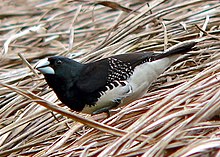| Black-and-white mannikin | |
|---|---|

| |
| In Douala, Cameroon | |

| |
| Subspecies S. b. nigriceps in Kenya | |
| Conservation status | |
 Least Concern (IUCN 3.1) | |
| Scientific classification | |
| Domain: | Eukaryota |
| Kingdom: | Animalia |
| Phylum: | Chordata |
| Class: | Aves |
| Order: | Passeriformes |
| Family: | Estrildidae |
| Genus: | Spermestes |
| Species: | S. bicolor |
| Binomial name | |
| Spermestes bicolor (Fraser, 1843) | |

| |
| distribution | |
The black-and-white mannikin (Spermestes bicolor) also black-and-white munia or red-backed mannikin, is a species of estrildid finch, widely occurring throughout the African tropical rainforest. It has an estimated global extent of occurrence of 4,200,000 km. It is found in moist savanna and subtropical or tropical moist lowland forest habitat. The status of the species is evaluated as least concern. They are seedeaters, but are known to feed on algae.
The black-and-white mannikin was formally described in 1843 by the British zoologist and collector Louis Fraser from a specimen collected near Cape Palmas in Liberia. He placed the species in the genus Amadina and coined the binomial name Amadina bicolor. The black-and-white mannikin is now one of the four species placed in the genus Spermestes that was introduced in 1837 by William Swainson.
Four subspecies are recognised:
- S. b. bicolor (Fraser, 1843) – Guinea-Bissau to Cameroon
- S. b. poensis (Fraser, 1843) – south Cameroon to south Sudan, southwest Ethiopia, west Kenya and the island of Bioko
- S. b. woltersi (Schouteden, 1956) – southeast DR Congo and northwest Zambia
- S. b. nigriceps Cassin, 1852 – central Kenya and south Somalia to east Angola, Zambia, Zimbabwe and east South Africa
The subspecies S. b. woltersi and S. b. nigriceps have sometimes been considered as a separate species, the red-backed mannikin.
References
- ^ BirdLife International (2017). "Spermestes bicolor". IUCN Red List of Threatened Species. 2017: e.T105968860A111180974. doi:10.2305/IUCN.UK.2017-1.RLTS.T105968860A111180974.en. Retrieved 13 November 2021.
- Savalli, U.M. (1989). "Black and white mannikins Lonchura bicolor eating algae". Scopus. 13: 136.
- Fraser, Louis (1842). "Amadina bicolor". Proceedings of the Zoological Society of London. 10 (117): 145. Although the volume is dated 1842 on the title page, the article was not published until 1843.
- Paynter, Raymond A. Jr, ed. (1968). Check-List of Birds of the World. Vol. 14. Cambridge, Massachusetts: Museum of Comparative Zoology. p. 371.
- Swainson, William (1837). On the Natural History and Classification of Birds. Vol. 2. London: John Taylor. p. 280.
- ^ Gill, Frank; Donsker, David; Rasmussen, Pamela, eds. (January 2023). "Waxbills, parrotfinches, munias, whydahs, Olive Warbler, accentors, pipits". IOC World Bird List Version 13.1. International Ornithologists' Union. Retrieved 10 February 2023.
- Payne, R.B. (2020). del Hoyo, J.; Elliott, A.; Sargatal, J.; Christie, D.A.; de Juana, E. (eds.). "Black-and-white Mannikin (Spermestes bicolor), version 1.0". Birds of the World. Ithaca, NY, USA: Cornell Lab of Ornithology. doi:10.2173/bow.bawman1.01.
| Taxon identifiers | |
|---|---|
| Spermestes bicolor | |
| Lonchura bicolor | |
This Estrildidae-related article is a stub. You can help Misplaced Pages by expanding it. |